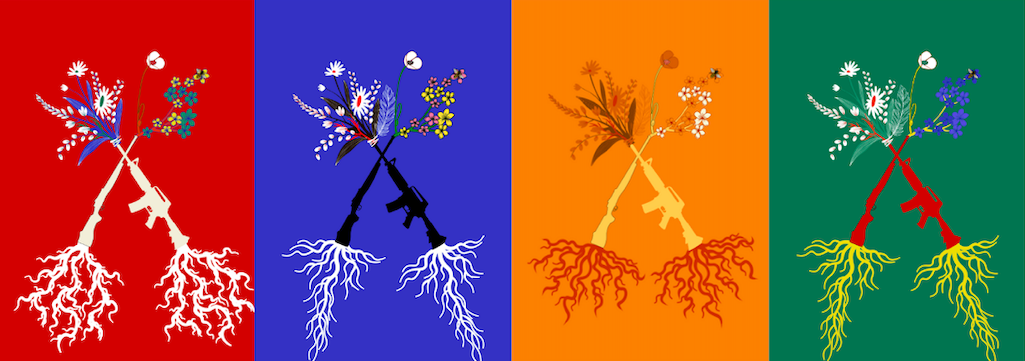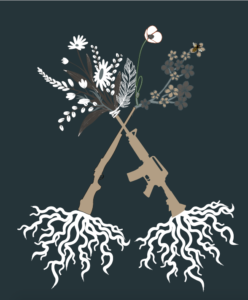Mission Statement
‘Visualising Peace’ is a ‘Vertically Integrated Project’ involving a team of undergraduate students from different Schools at the University of St Andrews. Directed by Dr Alice König, the project seeks to extend the work of the Visualising War project by examining how war’s aftermath, conflict resolution and peace-building are conceived. We study different habits of imagining, understanding, representing and working towards peace, and we are particularly interested in analysing how different narratives and ideas of peace have evolved and gained influence over time.
Our project has produced several outputs, including our Museum of Peace, the Visualising War and Peace Podcast, and a range of reports, blogs, short films and interactive tools published on our project pages. As part of our research, we have also explored the different ways in which the topic of peace is studied in different academic disciplines, and this has led us to create The Visualising Peace Library. This Library has two core aims. Firstly, it represents a footprint for our various research projects – in particular, our Museum of Peace. Secondly, it is designed not just to reflect the research that we have been doing but also to stimulate and expand future research. In bringing together a wide range of publications, from different disciplines and sectors, we aim to stretch (not reinforce) habits of studying, learning and thinking about peace.
Cross-disciplinary learning journeys
The project’s team includes researchers from eighteen different subject areas. Between us, we have selected and analysed a wide set of sources, ranging from academic journals, books, articles and commentaries to blog posts, podcasts, and reports by NGOs. Inevitably, it is a work-in-progress, reflecting our team’s personal interests and diversity of approaches. With each semester of development, we add new entries and update cross-references. Our aim is not to offer comprehensive coverage of all areas of Peace Studies; we could never fulfil that ambition. Instead, our goal is to introduce researchers to studies of peace and peace-building that they may not have come across before – either because they sit outside their subject area or because they sit outside academia itself.
We have deliberately sought out reports, podcasts, blogs and other publications that reflect and influence what peace practitioners do, with a view to encouraging more dialogue between theory and practice. Similarly, through our tagging and cross-referencing systems, we have tried to build pathways between publications on (for instance) medieval conflict resolution and 21st-century peace-building theory, or research into the ethics of peace journalism and the goals of peace education (to take just a couple of examples). Our hope is that visitors who follow up individual cross references or explore the range of items tagged under our cross-cutting categories will encounter ideas and approaches that take them out of their comfort zone and get them exploring peace in new ways.
The accumulation of different academic approaches to peacebuilding within our library has highlighted to us that there are some fascinating overlaps between disciplinary approaches as well as a range of contrasts. We believe that looking at these approaches together can allow us to come to a more nuanced and holistic approach to peacebuilding. We are building a growing portfolio of blogs and presentations to complement the resources we have gathered together in the Visualising Peace Library. Our goal is to promote more interdisciplinary cross-fertilisation and also more dialogue between university-based academics and professionals working in the wider peace-building sector. Students from different disciplines have taken time to highlight particular items or connections and contrasts between items which have struck them as offering fresh insights into peace or peace-building. We hope that you find these stimulating, as you explore the wider Library.
Using the Visualising Peace Library
To help users make cross-disciplinary comparisons, each bibliographic entry on our site is categorised according to its general subject area(s). We have also added tags to each entry that identify cross-cutting themes (like ‘Just War’ or ‘Cyber Security’), linking resources from multiple disciplines. The aim of this is to help users establish patterns across subjects, while also comparing the different approaches that academics working in the same field may take when studying peace.
Each bibliographical entry is accompanied by a short summary, outlining the item’s methodology and key takeaways, and links are also provided to online versions of the full text. Some items may only be accessible to users whose universities/organisations subscribe to certain online journals/ebooks, but we have tried where possible to focus on resources that are open-access.
This bibliographical resource does not promise to cover all aspects of peace studies in each discipline we cover, but we hope you will find it a helpful starting point as you conduct your own research and learn more about the different ways in which peace has been, and continues to be, studied in different disciplines. We encourage everyone to approach the sources we highlight critically; to consider where they are coming from and whose viewpoints they reflect; to think about the habits of visualising peace which different methodological approaches promote; and to consider what perspectives might be missing from our current selection.
We would love to hear what you think – and we hope that users will suggest other sources for us to analyse and include in future! If you have a few minutes to spare, please fill in this short feedback form. Thank you!

